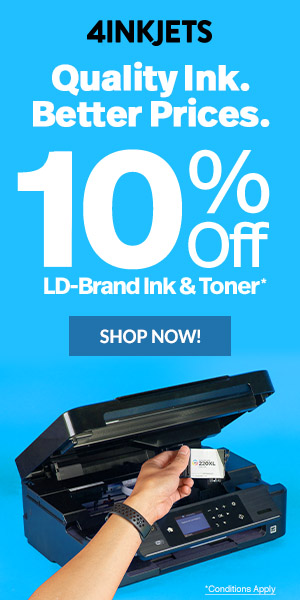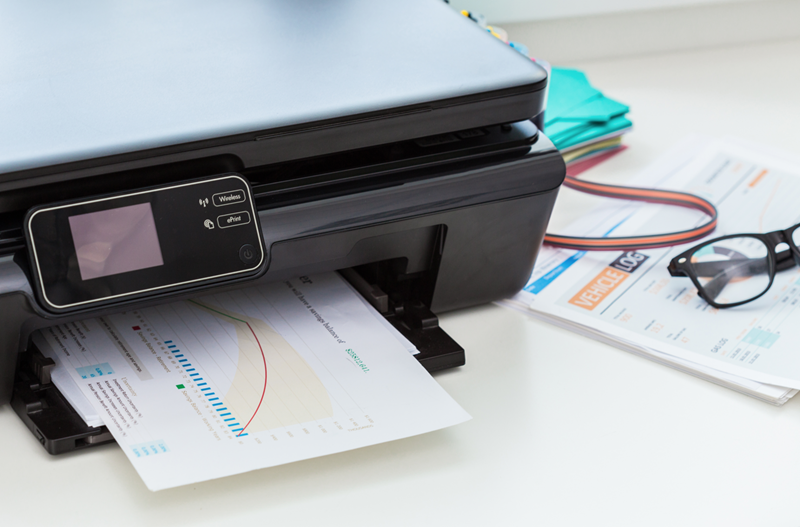Marketing professionals are always on the lookout for new and unorthodox ways to get attention. The digital marketplace today is a crowded place, and now more than ever creativity is needed to get your brand noticed. Arguably, some of the best options is sitting right under your nose, virtually unnoticed. Creatively adding print media back into your digital-heavy marketing strategy can do wonders for generating interest around your brand as well as driving traffic to your well-curated and optimized web presence.
According to Marketing Schools, consumers see non-traditional ads as “more organic, authentic, and relevant”. Non-traditional advertising with print is an opportunity for your brand to differentiate itself and establish a presence in the less saturated physical space while most businesses focus their efforts on digital advertising. Using the creative minds behind your website and digital ads to create something in print can do wonders for your online and offline branding. In fact, adding print to your existing digital strategy may just be the new non-traditional approach to advertising that you’ve been hunting for.
Here are some reasons why adding print is such an effective marketing approach:
Print puts you in a different headspace.
In 2009, the Queensland Board of Tourism hired creative agency Nitro to help them make a big splash, and they did using an unconventional approach: a swimming pool. Well, more than just that, they put an ad in the jobs section of newspapers, advertising the “Best Job In the World”—cleaning a pool, feeding the fish, and earning $150K in six months. This ad created a PR firestorm, partly because of its unique placement. According to Hubspot, the Board received 7 million online visitors, as well as 34,000 people from 200 countries that recorded one-minute “application” videos. What a response!
With an ever-growing percentage of the American workforce spends the majority of the day looking at digital screens, print allows readers to step away from the buzz and distractions of the internet, and focus their attention. Whether you’re reading a newspaper or magazine, or you’re checking your daily mail, print inhabits your physical space and invokes a certain type of zen. On the contrary, reading from LED screens is physically taxing, and stepping away from that makes you receptive to information in a different way.
Print is exciting.
New and uncommon things are exciting, especially those that you don’t always see or get. Non-traditional means of communication allows you to leave a big impression, and the bigger you go the bigger your message becomes–literally. For instance, skywriting, or on a banner being dragged by a plane–these atypical advertising methods excite people and generate buzz.
I don’t know about you, but getting something in the mail still excites me. This excitement is why direct mail still works, even in the age of the web. A 2014 Neilson study analyzing the ways consumers arrive at purchasing decisions found that circulars, whether sent direct mail or distributed in-store, informed a higher percentage of choices than any digital approach—including emails, apps, websites, blogs, and social.
Part of the reason print can be more exciting than its digital equivalent is the physicality of it. When you get something on paper, it has a touch and weight that you interact with, resulting in more engagement of the senses. And with the declining amount of mail we get, eye-grabbing items easily stand out and catch your attention.
Print equals authority.
Even among the youngest adults, print is seen as authoritative and official than precisely the same documents served up digitally. According to a survey performed by TRU, Millennials preferred print to digital documents, because they are seen as: more official (88%), more trusted (82%), easier to keep confidential (78%), and safer/more secure (74%). This association of print with authority extends to media, with Millennials widely preferring books, magazines, and newspapers over their digital alternatives. Surrounded by unreliable information on the web, we associate printed media with a cultural belief that it’s more believable.
Analog is alive.
People like to own things physically as well as digitally. Downloading and streaming have transformed several industries, most notably the music industry, which is still learning how to cope with changes in revenue. Some savvy artists have realized that giving away your product online can lead to bigger returns in terms of analog media sales (not to mention live performances). The Grateful Dead employed this tactic as early as the late 1960s, allowing fans to record and share their live shows and creating an almost cultish following of devotees. A recent example of this phenomena comes from Radiohead’s In Rainbows release, which gave the listener an option to pay what they felt was right, and also pre-order the album while streaming the record online.
In case you haven’t noticed, a whole lot of things deemed dead-on-arrival more than a decade ago are thriving. In some instances, such as vinyl records, the small community of enthusiasts who kept the medium alive through the dark days of CDs and CD burning have inspired a new generation of people firmly rooted in the mainstream, revitalizing what was once seen as a dead craft. Boutique-quality letterpress catering to the sense of humor and uniqueness of young people have kept quality handmade print goods on the market as well. You could even argue that podcasts are little more than radio shows, digitalized for a wider audience.
A lot of young people these days still subscribe to magazines that cater to their interests or signify their social standing, as is often the case. Getting reputable information on products, news and views, and helpful tips you can trust is often worth the cover price. Placing an ad where these interested readers go for information cuts through the data and puts you in the hands of someone who cares.
Print can be precise.
Broad-based, wide-reaching print publications like newspapers have fallen on hard times. Simultaneously, published journals and reviews for specialty interest markets are flourishing, and their advertisers are getting better returns than anywhere else. Why is this?
Because the web has made free information more accessible, it helped people with niche interests easily find one another. For example, if you’re interested in building model ships, you’re only a Google search away from a wealth of information on tiny frigates and brigs of all varieties, as well as a community of message boards and forums rife with information. With this ready availability comes some side effects however, especially for more intricate fields of interest. At the end of the day, more voices doesn’t necessarily lead to more authority. In fact, quite the opposite is often true. It’s still a question of whether or not these voices have credible expert knowledge on the subject. Enthusiasts today are gravitating back towards print for authoritative information they can rely on, from tricks of the trade to unbiased reviews of new products.
For marketers, this allows for a degree of specialization that touches a wider market. Joe Pulizzi at Content Marketing Institute writes that “highly niche, highly targeted publications are flourishing as a marketing tool.” He goes on to note that traditional content channels aren’t dying like they were early in the new millennium, they’re just viewed differently than when they were the only source of information.
Print is more direct than digital.
In 2015, ad blocking grew by 30.7 percent according to AdAge. This recent uptick is putting a major pinch on digital-only publishers, pushing even widely-read outlets out of business. It also means that advertisers who pay to have their message delivered to a target market aren’t reaching everyone they think they wi
Hoping to generate clicks and views for advertisers, other online publishers are resorting to autoplay videos, which freeze up slower browsers and annoy readers. There are several sites I’ve read for years that my not-all-that-old laptop can’t keep up with anymore, which results in me looking elsewhere for the same information.
Print magazines and newspapers, on the other hand, simplify turning content into cash. Subscription magazines make monetizing simple: people who want the content pay a small fee, and advertisers pay a flat rate to have their visual presented to those people. Most successful print outlets today have a dedicated fanbase that will trust advertising more than your casual web reader. And direct mail similarly circumvents ad blocking by putting your ad somewhere your recipient must address it—their address!
When brainstorming award-winning concepts that propel brands into the public eye, most marketers aren’t thinking about print media. This oversight cuts out a vast creative advertising space that is uncluttered and largely without radical innovation.
From a consumer’s perspective, print advertising has always boiled down to an image and copy that pair together to build out a narrative and for them, this is how it’s been since the birth of advertising. It is for this reason that consumers don’t usually expect innovation when they open a magazine or check the mail. Their expectations are established and static. And, as many a tech mantra suggests, defined boundaries and expectations create a space you can invade and disrupt.
Here are a couple of great ideas that can disrupt consumer expectations:
Incorporate Technology
Chips, LCDs, and audio nodes are smaller and cheaper now than ever before. Even a couple years ago, adding a sophisticated technological component to a print ad would be prohibitively expensive, but not anymore. It’s not entirely uncommon today to encounter mass-production ads that are fully integrated with technology so to make them interactive and unique. Nivea won the Mobile Grand Prix prize at Cannes in 2014 for their print ad which included a wristband tracker designed for parents to monitor their kids at the beach. According to Hubspot, the app allowed parents to set distance alerts and pinpoint position.
Digital Hacks
Apps designed to interact with print media have been around for about a decade now, most popularly seen in the form of QR codes. These codes direct consumers to video content, websites, and games instantly, making access to digital ads available to anyone, anywhere. Some companies are now taking the idea of print-to-digital connectivity to the next level, designing apps that seem not just to read the code but play along with the ad directly. Take for example this app by Kontor Records that seems to play music from a vinyl record. Set up your paper record player and use your iPhone as a stylus. Neat!
Think Ink
Most print innovations in recent years came not from printing hardware as much as the ink printers use. For photographers, that means sharper and more color-correct images at home, but that’s only the tip of the proverbial iceberg. Heat sensitive inks have been around for a couple of decades now, but their use in advertising is still relatively limited. Inks designed to change color or appear in sunlight are new to the game, but they should see wider creative use in the coming years, too. Designed for Israeli energy company Shikun & Binui Solaria in 2011, this charming sunlight-sensitive ad promotes solar power by being solar powered itself.
Connect to the Wider World
People share things with their network to curate their feed and show off their personality. Marketing experts suggest including social media on your print ads to give viewers the ability to share them like digital ads to increase their reach. Others recommend print add-ons to packaging incorporate “selfie bait” into the unboxing process, designed to inspire online postings about the experience on social media. Frank, a company that makes popular skincare products, generated a lot of buzz organically by promoting selfies with customers using their unique product. They’ve even pulled together a how-to guide to help you do it right.
Motion
Allowing for interactive movement in your ad is one thing, but making that motion elegant can inspire a whole campaign. Smart visuals in motion are great for capturing on video for cross promotion across different platforms, especially social media. Well shot video combined with sophisticated movement make your print ad highly shareable and attractive to influencers on Facebook and Instagram looking for content. Here are four ads that caught the eye of Trend Hunter with their clever use of technology, motion, and more.
Adding print to your existing digital strategy tweaks a tried-and-true advertising method for the modern age. Advertising in print allows you the chance to precisely corner your target market by researching their interests. Be creative and see where your mind takes you!







Leave a Reply